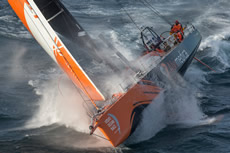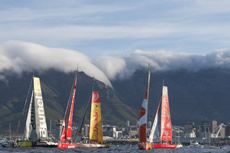0-40 knots start from Cape Town
Cape Town laid on brisk conditions with 35 knot gusts for the start of the Volvo Ocean Race's 6,125 mile second leg round the bottom of South Africa and up the Indian Ocean to Abu Dhabi.
The start took place at 1600 UTC. The seven boat fleet had readied itself for pounding into 35 knot southeasterly winds on their approach to the Cape of Good Hope further south, Abu Dhabi Ocean Racing sailing with two reefs in her main, while the others had one. Despite this, on the line it was a virtual drift, as they struggled to break out of the wind shadow of Table Mountain. But in less than two minutes, MAPFRE had broken clear and into 35-knot winds. On the race to the bottom of the course, the teams were barely in control as they ploughed through big waves at 25 knots boat speed or more. Team Alvimedica was chasing in the leaders in 3rd place, but as they came to the top of the first lap and back into the shadow of Table Mountain, it was a restart as all the boats bunched back together.
As Yann Riou, Dongfeng Race Team's OBR, described it:“0 to 40 knots before we’ve even left Cape Town”.
After a brief lap of Table Bay, Bouwe Bekking's Dutch-flagged Team Brunel led the fleet out of Table Bay after wrestling the lead, first from MAPFRE and then Team SCA. As they raced past Green Point the fleet drifted into another wind shadow and this time it was Team Alvimedica's turn to take a tenuous lead. After the first hour, it remained very close and very changeable.
The race organisers have added some more marks to the 'East Africa exclusion zone, the most important being at 05° 41.000’S 60° 00.000’E, taking the boats marginally further east of the Seychelles than the great circle would have taken them before. This measure has been introduced to the long term forecast indicating possible cyclone activity in the area.
Team Vestas Wind surprised onlookers when a choir on board their support boat burst into song just prior to the start. Their message was loud and clear: 'There's an even more important race we must win - to save the environment'.
Prior to leaving Team Alvimedica's skipper Charlie Enright warned: “We’re expecting a pretty heinous sea state. The first two nights are going to be difficult to manage. The breeze is up for the first night, then the breeze drops off for the day and picks up again as we cross the Agulhas Current on the second night.”
Conditions off the south of South Africa can be lumpy in the extreme with the Agulhas Current, which Team Alvimedica navigator Will Oxley warned can reach 4-5 knots, meeting the typically strong westerlies and with the sea bed steeply rising.
Leg 2 is expected to take between 22 to 28 days to complete, depending on conditions. Team Alvimedica skipper Charlie Enright anticipates many obstacles on the 6,125-mile passage to the next stopover in the Persian Gulf. “We’re thinking maybe 27 days to get to Abu Dhabi, although we’re putting on enough food for 30. It could be rough heading out of Cape Town, with the potential for big breeze and fast currents. Once we get up towards Madagascar we’re heading towards the unpredictability of the tropics. There’s talk of tropical storms throwing themselves in our path, so there are some challenging obstacles to negotiate. It could be a tricky game of snakes and ladders, but we can’t wait!”
Images below from Gilles Martin-Raget (Team Alvimedica), Ainhoa Sanchez (aerials), Marc Bow and Charlie Shoemaker/Volvo Ocean Race on the water
 |
 |
 |
 |
 |
 |
 |
 |
 |
 |
 |
 |
 |
 |
 |
 |
 |
 |
 |
 |
 |
 |
 |
 |
 |
 |
 |
 |
 |











Latest Comments
Add a comment - Members log in